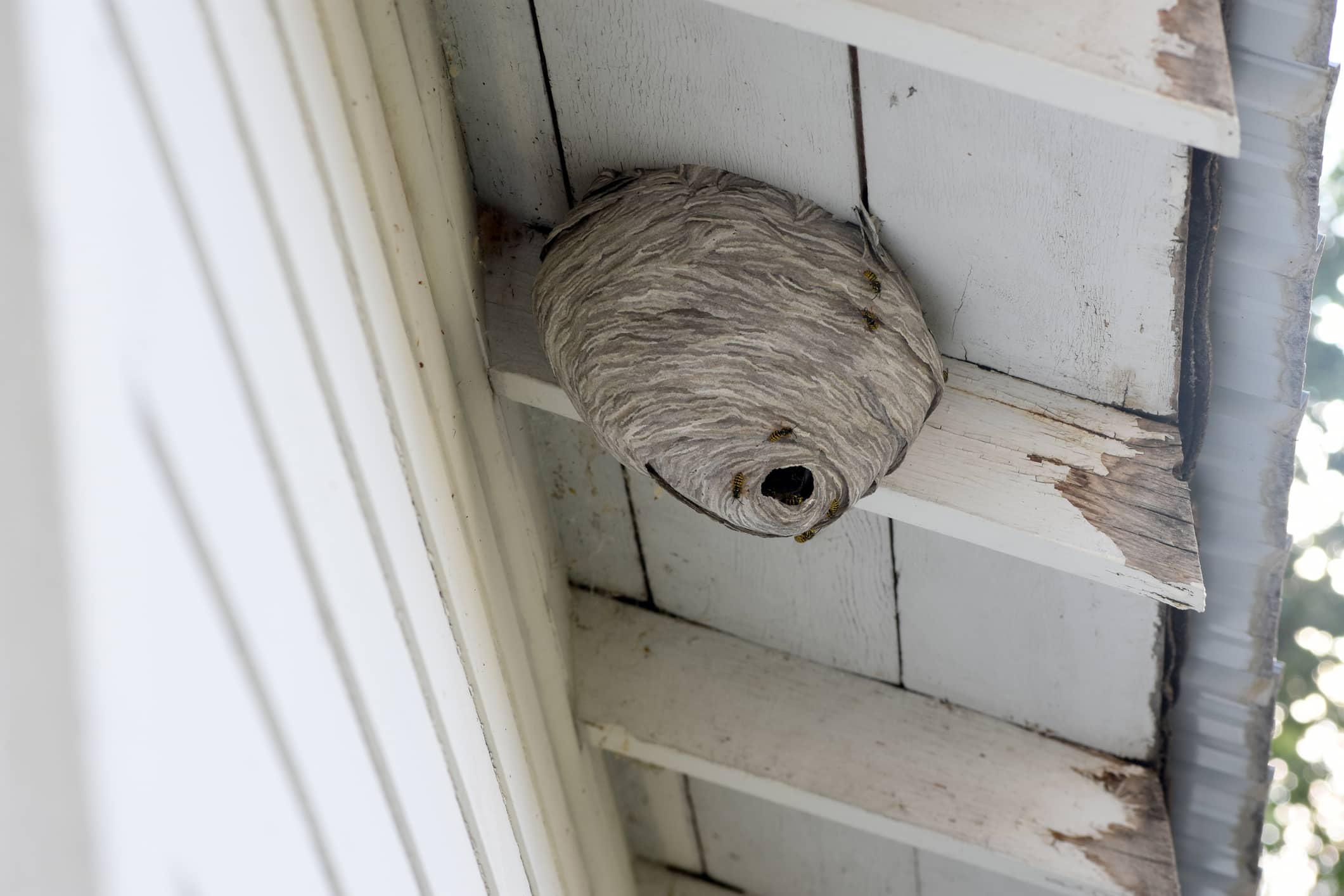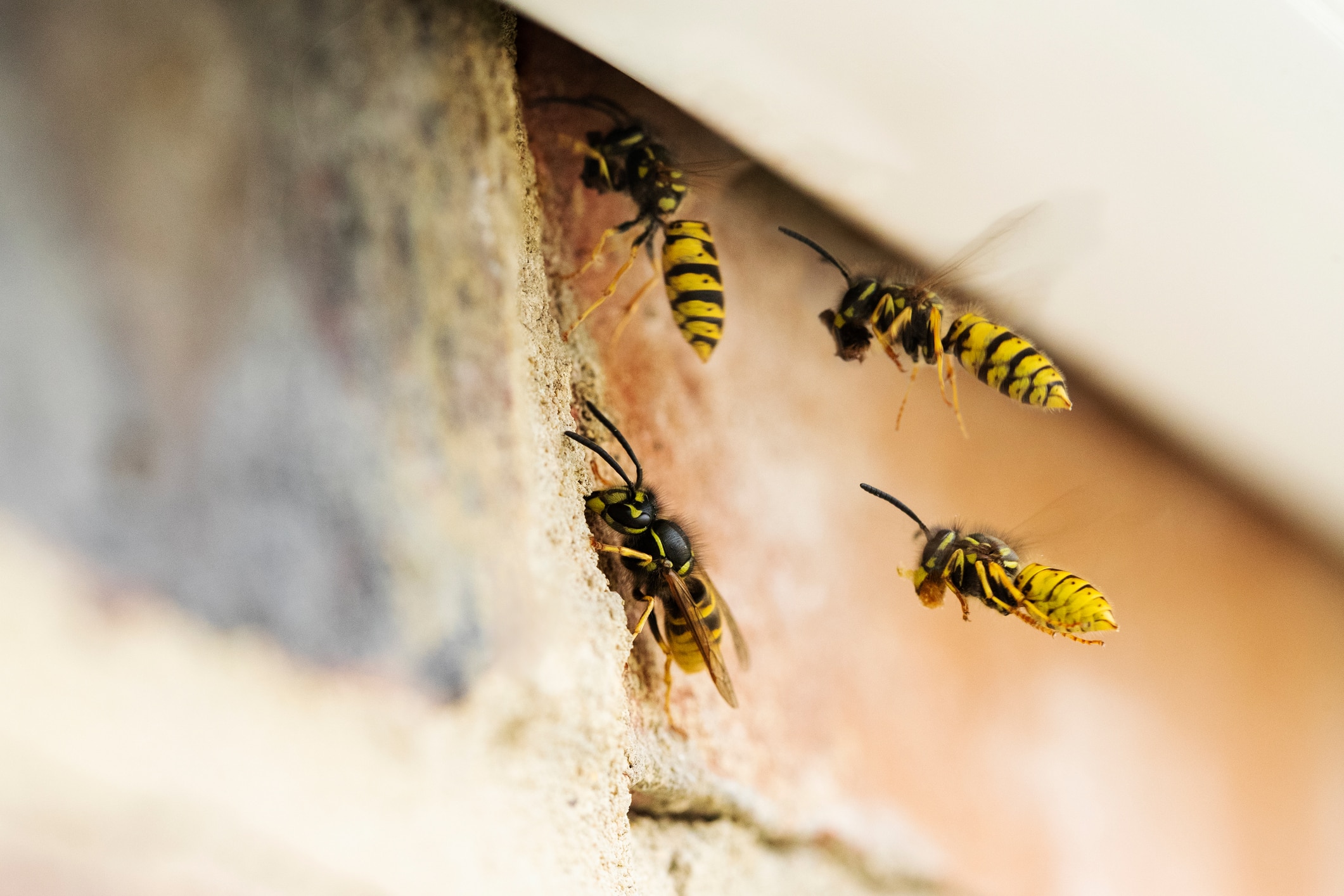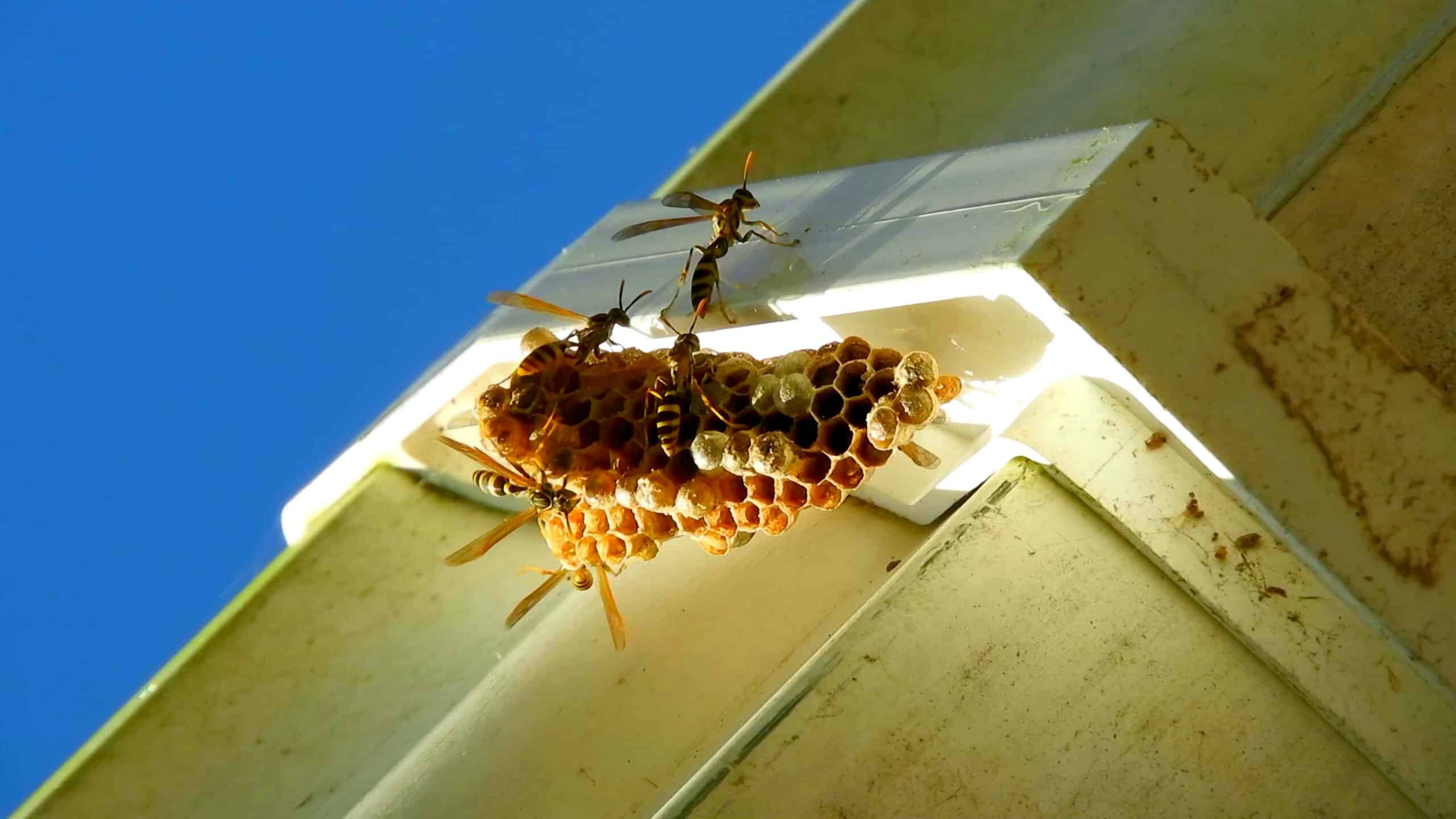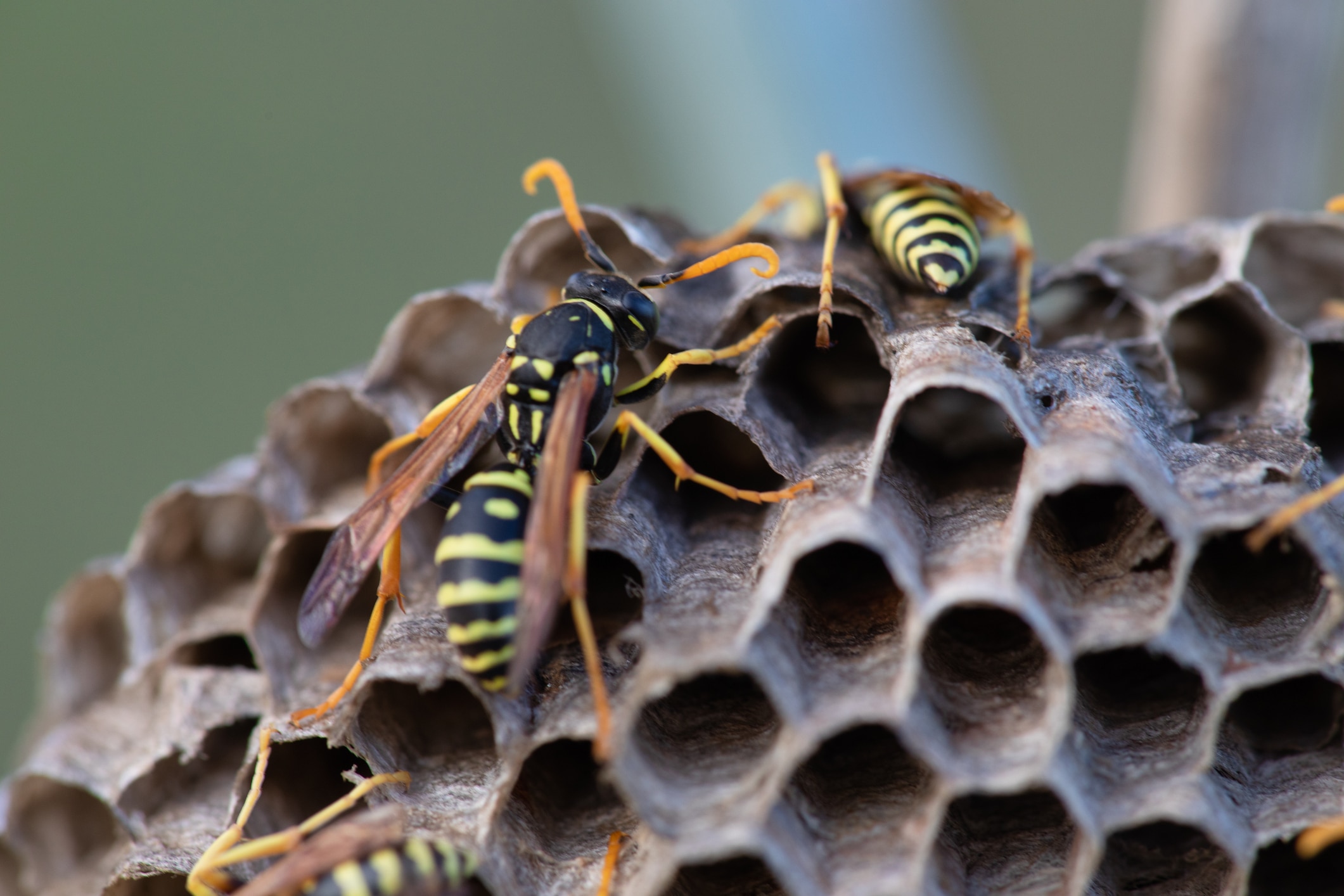
Humane Wasp Control Services in Michigan
Are you dealing with a wasp problem at your home or business? Creature Control manages pest-related issues with a compassionate approach. Our integrated pest management methods address wasps life cycle and behaviors, ensuring a thorough and humane approach to wasp control.
We provide specialized pest control services without needing long-term contracts, prioritizing the safety and well-being of your property and its occupants. Our team of professionals uses advanced techniques to effectively address wasp infestations. Contact us today for prompt and humane wasp control services. Let Creature Control restore peace and safety to your living or working environment.
Signs of a Wasp Infestation
Recognizing the signs of a wasp infestation is crucial for maintaining a safe and comfortable environment in your home or business. With their territorial nature and aggressive behavior, wasps pose a significant threat to both occupants and property. By being vigilant and observant of certain indicators, you can proactively address any potential infestations before they escalate.
- Presence of a Visible Wasp Nest: Wasps construct nests in various locations, such as under eaves, attics, or within tree branches. These nests can vary in size and shape depending on the species of wasp and the stage of colony development. Spotting a physical nest is an obvious indication of an infestation and warrants immediate attention.
- Heightened Wasp Activity: During warmer months, wasp activity typically increases as they forage for food and tend to their nests. If you notice a surge in the number of wasps buzzing around your property, especially around potential nesting sites, it could signal the presence of an infestation.
- Aggressive Behavior From Wasps: Wasps protect their nests and can exhibit aggressive behavior, especially if they feel threatened. Disturbing a nest or approaching too closely may result in swarming and stinging attacks, posing a danger to anyone nearby.
- Surge in Wasp Stings: An increase in wasp stings, particularly in localized areas, strongly indicates a nearby nest. Wasps defend their territory vigorously, leading to more frequent encounters and potential stings if the nest is disturbed.
- Observation of Nest Building Activities: If you observe wasps repeatedly entering and exiting a specific location and discovering chewed wood or other building materials nearby, it suggests active nest building. Wasps construct their nests using materials like wood fibers or mud, often in secluded areas away from direct sunlight and potential disturbances.
If you notice any signs of a wasp infestation, it’s essential to take prompt action to address the issue. They can pose a significant threat to individuals, especially those allergic to their stings, and may cause damage to property if left unchecked. Creature Control’s professional pest control assistance will safely remove the nest and manage the infestation, ensuring the safety and well-being of occupants and the premises alike.

Five Most Common Species of Wasps in Michigan
In Michigan, encountering various types of wasps is common, especially during warmer months. These stinging insects play important ecological roles but can also threaten humans due to their aggressive behavior and painful stings. Understanding the different types in Michigan can help residents and visitors recognize potential hazards and take appropriate precautions.
- Yellowjackets: Yellowjackets are perhaps the most familiar type in Michigan. They are easily recognizable by their black and yellow striped bodies and are known for their aggressive behavior, especially when their nests are disturbed. Yellowjacket nests are often found underground or in protected locations such as wall voids, attics, or shrubbery.
- Paper Wasps: Paper wasps have slender bodies and long legs, with wings that fold lengthwise at rest. They build distinctive umbrella-shaped nests from a paper-like material, which they construct by chewing wood fibers with saliva. These nests are often attached to eaves, door frames, or other sheltered locations.
- Bald-Faced Hornets: Despite their name, bald-faced hornets are a type of wasp rather than a true hornet. They are larger than yellow jackets and have distinctive black-and-white markings on their bodies. Bald-faced hornets build large, spherical nests typically attached to trees, shrubs, or buildings. They can be aggressive when their nests are threatened.
- European Hornets: European hornets are an introduced species in Michigan and are larger than most native types. They have brown bodies with yellow markings and build large paper nests, often in hollow trees, attics, or wall voids. European hornets are generally less aggressive than others but can sting if provoked.
- Eastern Cicada Killer Wasps: Eastern cicada killer wasps are large, solitary ones active in Michigan during summer. They have yellow and black markings and are known for hunting cicadas to provision their nests. Despite their intimidating size, they are generally not aggressive towards humans unless directly threatened.
Awareness of the most common types in Michigan is essential for maintaining safety, particularly during outdoor activities. Recognizing each species’ distinctive characteristics and nesting habits can lower the risk of stings and ensure a more enjoyable outdoor experience. Remember to exercise caution around wasp nests and contact Creature Control if faced with a potential infestation.

What Are the Differences Between Bees & Wasps?
Bees and wasps, belonging to the order Hymenoptera, exhibit distinct characteristics that differentiate them in appearance, behavior, and ecological roles. While they share similarities in flying insect status, their divergent evolutionary paths have led to unique adaptations suited to their lifestyles. Understanding these differences is essential for understanding what pest problem you have.
- Physical Appearance: Bees have robust, hairy bodies with branched hairs for pollen collection, while wasps have slender bodies with smooth, shiny exoskeletons and distinct coloration patterns.
- Diet: Bees feed on nectar and pollen from flowers, whereas wasps are more carnivorous, preying on insects and scavenging for other food sources.
Social Structure: Many bee species are social, living in colonies with a queen, drones, and workers, while there are solitary and social wasps with varying degrees of social organization. - Nesting Behavior: Bees construct nests out of wax, often sheltered, while wasps build nests using paper-like materials found in various locations.
- Stinging Behavior: Bees are less aggressive and sting primarily in defense, leaving their stinger behind, whereas wasps can be more aggressive, with some species capable of multiple stings.
Bees and wasps are vital in ecosystems as pollinators, predators, and scavengers. Their contrasting behaviors, from the social structures of bee colonies to the hunting habits of wasp species, reflect their diverse ecological niches. By recognizing and appreciating these differences, you can better understand what pest population affects your property.
Wasp Control FAQs
To remove wasps without causing harm, you can use natural repellents such as peppermint oil or citronella. Another option is to set traps with sugar water to catch and release them. Additionally, sealing entry points to your home can help keep them out. Planting herbs like mint, basil, or lemongrass can also deter them. If needed, hire our humane pest control services. Not only can we humanely remove the infestation, but we can also ensure that you don’t get hurt from stings.
First, carefully observe the flight patterns of the wasps, as they often fly directly to and from their nest. Once located, approach the nest cautiously during the early morning or late evening when they are less active. Use protective clothing, such as long sleeves, pants, gloves, and a veil, while slowly applying an appropriate insecticide directly to the nest, following the product’s instructions carefully.
After ensuring all wasps are eliminated, cautiously remove the nest, avoiding any remaining wasps or re-infestation. As you likely picked up reading this response, pest control is a dangerous process. To ensure safe and effective removal, seek assistance from our team. We can protect you and your property while humanely solving your pest problem.
Several natural or DIY remedies can help repel wasps effectively. Still, while these methods can help somewhat, it’s important to note that they may not be as potent as professional-grade insecticides. However, peppermint oil, citronella, and cloves are all scents that wasps find unpleasant, so using them in sprays or diffusers around your home can deter them from nesting. Additionally, creating a spray with lemon slices and cloves or using essential oils like lemongrass, eucalyptus, and tea tree oil mixed with water can be effective repellents.
All that being said, you should still hire a professional pest control service for a wasp infestation. Creature Control prioritizes your and your property’s safety, offering humane solutions to address pest issues.
The best precaution you can take is to not deal with the infestation and hire a professional instead. When you’re near the nest, you should wear protective clothing such as long sleeves, pants, gloves, and closed-toe shoes to minimize exposed skin. Only approach the nest early or late evening when they are less active, and use a flashlight if inspecting nests in dark areas.
Avoid swatting at them or making sudden movements that could agitate them. Use care when applying insecticides, follow product instructions carefully, and keep children and pets away from treated areas. While we always recommend hiring Creature Control, you should not even consider attempting a DIY solution if you’re allergic to their stings.
The best time is during the early spring or late fall when their activity is typically lower. During these periods, the queen established or abandoned nests, making locating and eliminating them easier.
Additionally, cooler temperatures decrease their activity, reducing the likelihood of encountering aggressive behavior. However, if addressing an active infestation during warmer months, early morning or late evening is preferable when they are less active.
Regardless of the season, caution and proper protective gear should always be employed around wasps to minimize the risk of stings. And instead of addressing an infestation yourself, hiring Creature Control can ensure your safety and a humane solution.

Hire Creature Control for Humane Insect Control Services
Protect your home from insect infestations with Creature Control. Our professionals specialize in humane pest control, ensuring the safety and cleanliness of your property. Our dedicated team protects your environment, whether it’s wasps or other pests. Don’t wait; schedule our services today to protect your home and family from pest-related concerns